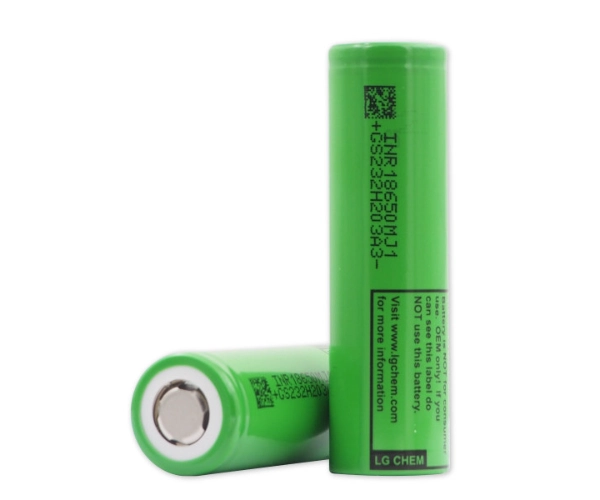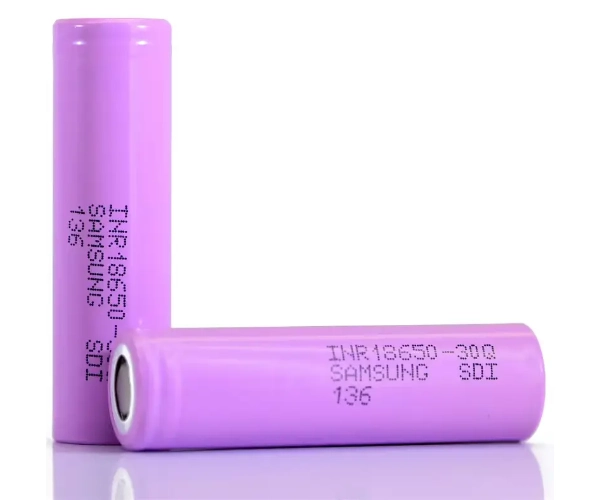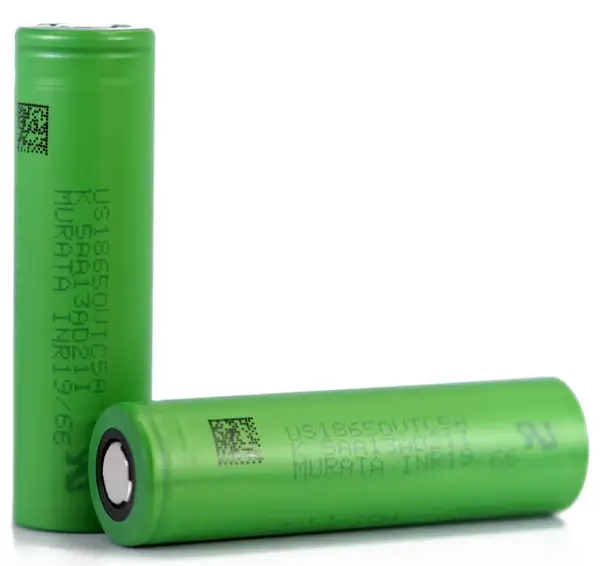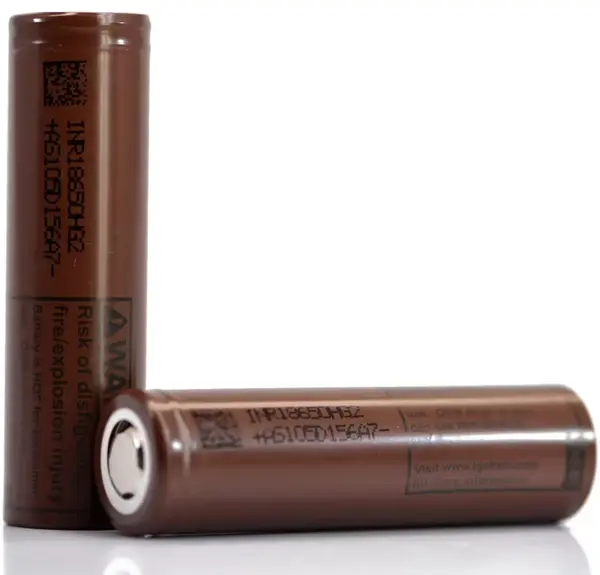
Choosing the right 18650 vape battery ensures safety, power stability, and long device life. This guide compares the top 10 18650 vape batteries and helps you find the best match for your vape mod or pen.
Key Takeaways
- ✅ Safety First: Match the CDR to your device’s wattage output
- ⚡ For High Power: Pick 25A+ CDR batteries (e.g. LG HB6, Sony VTC5A)
- 🔋 For Longevity: 3000mAh+ cells like LG HG2 work best for daily use
- ⚠️ Stay Authentic: Buy only genuine Samsung, LG, or Sony cells
Part 1. What to look for when choosing an 18650 vape battery?
Take into consideration the following characteristics when selecting an 18650 battery that is ideal for vaping:
- High discharge rate: 18650 batteries explicitly designed for vaping typically have high continuous discharge rates of 10A to 30A or more.
- Durability: The capacity of these batteries ranges from 1800mAh to 3500mAh.
- Safety elements include ensuring the appropriate chemical level and the presence of integrated protective circuits.
- Check unique markings: Special markings include the product’s brand, voltage, capacity, rate of discharge, and any other information marked on the battery.
Part 2. Top 10 18650 vape batteries for every vaper
| Battery Model | Capacity (mAh) | Continuous Discharge Rate (CDR) | Max Wattage | Best For | Notes |
|---|---|---|---|---|---|
| Ufine 3.7V 3000mAh | 3000 | 15A | ~70W | Everyday vaping | Balanced power & safety |
| LG HB6 | 1500 | 30A | 100–150W | High-power mods | Extreme performance |
| Sony VTC5A | 2600 | 25A | 100W | Sub-ohm vaping | Great balance of current & life |
| LG HG2 | 3000 | 20A | 75–100W | Long battery life | Popular all-rounder |
| Samsung 25R | 2500 | 20A | 75–90W | Reliable daily use | Durable and affordable |
| Sony VTC6 | 3000 | 15A | 60–70W | Moderate wattage vaping | High capacity, lower CDR |
| Samsung 30Q | 3000 | 15A | 60–70W | Flavor vaping | Efficient and smooth output |
| MXJO 35A 3000mAh | 3000 | 20A (claimed 35A) | 80–100W | Cloud chasing | Check authenticity |
| Panasonic NCR18650B | 3400 | 6.8A | <40W | Low-wattage pens | Longest runtime |
| EFest IMR 3000mAh | 3000 | 20A | 70–80W | Casual vaping | Good budget choice |
1. LG MJ1 18650
Model: LG MJ1 18650
Specification:
- Capacity: 3500mAh
- Discharge rate: 10A
- Average voltage: 3.6V
- Lifespan: Up to 400 cycles
Best For: Low-wattage pens (under 50W), all-day vaping sessions.
Pros:
- It has a high capacity of 3500mAh with extended usage.
- It is a reliable brand for quality batteries.
- It consists of an extended lifespan of 400 cycles.
Cons:
- It has a low discharge rate of 10A
- Not fitting for high-power devices.
- The cost is considered expensive.
2. Hohm Tech Hohm Life 18650
Model: Hohm Tech Hohm Life 18650
Specification:
- Style: Flat top
- Nominal capacity: 3015mAh
- Discharge current: 22.1A
- Nominal voltage: 3.65V
- Maximum voltage: 4.2V
- Cut-off voltage: 1.95V
Best For: Balanced performance in 60-80W mods, temperature control vaping.
Pros:
- It has a high capacity of 3015mAh and extended usage.
- >The 22.1A discharge rate is appropriate and appropriate for vaping devices.
- The sophisticated safety features, such as cell chemistry, enhance longevity and safety.
Cons:
- Perceived to be a costly alternative in comparison to other possibilities.
- Usually, somewhat heavier
- Specific configurations may result in portability problems.
3. Ufine 3.7 V 3000mAh 18650 Battery
Model: Ufine 18650 3000mAh
Specification:
- Capacity: 3000mAh
- Voltage: 3.7V
- Energy: 11.1Wh
- Max. charge voltage: 4.2V
- Discharge cut-off: 2.75V
- Max. charge current: 3000mA
Best For: Mid-range devices (50-70W), eco-conscious vapers.
Pros:
- It has a long-lasting capacity of 3000mAh.
- Eco-friendly and ideal for many-use cycles.
- It includes safety features such as prevents from overcharging and over-discharging.
Cons:
- Consists of limited cycle life
- It has an average discharge rate of 3000mA.
4. LG HB6 18650
Model: LG HB6 18650
Specification:
- Capacity: 1500mAh
- Discharge rate: 30A
- Nominal voltage: 3.6V
Best For: High-drain devices (100W+), mechanical mods, competitive cloud chasing.
Pros:
- It has a high discharge rate of 30A.
- An affordable choice for Performance-Balanced batteries.
- Resistance capabilities that would not go down to 12 ohm0. 12 ohm.
Cons:
- Its battery is weak, with 1500mAh endurance.
- Mainly applied in the places that have higher powers.
5. Samsung 30Q
Model: Samsung 30Q
Specification:
- Style: Flat top
- Nominal capacity: 3000mAh
- Discharge current: 15A maximum continuous, 25A pulse discharge
- Nominal voltage: 3.6V
- Maximum voltage: 4.2V
- Cut-off voltage: 2.5V
Best For: Everyday vaping in 40-75W devices, flavor-focused setups.
Pros:
- It has a high capacity of 3000mAh, which is ideal for long-lasting performance.
- It is an affordable vape battery of good quality.
- Suitable for average usage.
Cons:
- It has a low discharge rate of 15A and continuous discharge.
- It performs moderately and is not the best fit for high-drain applications.
6. Samsung INR18650-30Q
Model: Samsung INR18650-30Q
Specification:
- Capacity: 3000mAh
- Discharge rate: 15A
- Nominal voltage: 3.6V
Best For: Budget-friendly 30-60W mods, lower coil resistance vaping.
Pros:
- A good balance between capacity and discharge rate must be maintained.
- Affordable and budget-friendly battery.
- Widely suitable for 30-60W mods
- It supports lower coil resistance.
Cons:
- It has only a moderate capacity of 3000mAh.
- It consists of an intermediate discharge rate of 15A.
7. Sony US18650 VTC4
Model: Sony US18650 VTC4
Specification:
- Capacity: 2100mAh
- Discharge rate: 30A
- Nominal voltage: 3.7V
Best For: Extreme sub-ohm builds (0.1-0.2Ω), high-wattage box mods.
Pros:
- Consists of a high discharge rate of 30A (80-120W).
- Sony is a reliable and respectable battery producer.
- Comprise a price that is competitive and aligned with performance.
Cons:
- Its capacity is 2100mAh, which is less.
- Ideal for high-power gadgets.
- Less adaptable for usage with less power.
8. Sony VTC5A
Model: Sony VTC5A
Specification:
- Style: Flat top
- Nominal capacity: 2600mAh
- Discharge current: 25A maximum continuous, 35A with 80°C cutoff
- Nominal voltage: 3.6V
- Maximum voltage: 4.2V
- Cut-off voltage: 2.0V
Best For: Sub-ohm vaping (0.15-0.3Ω), regulated mods up to 90W.
Pros:
- It has a high discharge rate of 25A continuous and 35A.
- It consists of a balanced performance for sub-ohm vaping.
- Sony is a reliable brand for high-quality batteries.
Cons:
- It has a moderate capacity of 2600 mAh.
- It may be heavier, roughly 47.8g, depending on your device.
9. Hohm Tech Hohm Mega 18650
Model: Hohm Tech Hohm Mega 18650
Specification:
- Style: Flat top
- Nominal capacity: 2505mAh
- Discharge current: 22A
- Nominal voltage: 3.65V
- Maximum voltage: 4.2V
- Cut-off voltage: 2.5V
Best For: Advanced vapers using DNA/Yihi chipsets, safety-focused devices.
Pros:
- The ideal discharge current is 22 amps.
- It possesses advanced technology, including DS technology.
- It consists of stable performance, including the 2nd Gen Cathode Tag.
Cons:
- It has a moderate capacity of 2505mAh, less than a higher capacity.
- The weight might be heavier.
10. LG HG2
Model: LG HG2
Specification:
- Style: Flat top
- Nominal capacity: 3000mAh
- Discharge current: 20A maximum continuous
- Nominal voltage: 3.6V
- Maximum voltage: 4.2V
- Cut-off voltage: 2.0V
Best For: Long-lasting 60-80W performance, cool-running setups.
Pros:
- It has a high capacity of 3000mAh, suitable for a long lifespan.
- Possess an ideal discharge rate of 20A.
- It has a reliable performance known to maintain calm and safe operating temperatures.
Cons:
- It has a mid-range discharge rate of 20A.
- The battery weight may be heavier and add weight to your device.
Need Custom Battery Solutions?
Looking for OEM or custom vape battery packs? Ufine offers custom 18650 vape battery solutions with built-in protection circuits and small-order flexibility. Perfect for vape manufacturers or DIY mod builders.
🔋 Expert Tip from Ufine Battery Engineers: Always match your vape device wattage to the battery’s Continuous Discharge Rating (CDR). For vape mods under 70W, use 15–20A batteries; for high-wattage mods above 100W, choose 25A–35A batteries like LG HB6 or Sony VTC4. This ensures both performance and safety.
Part 3. What factors you should consider when choosing 18650 vape batteries?
The following are essential things to think about while buying 18650 Vape batteries:
1. Continuous Discharge Rating (CDR)
The battery’s Continuous Discharge Rating (CDR) is one of the most important specifications to check. This indicates the maximum current the battery can continuously discharge without overheating or damaging itself. If you’re using a device that requires a lot of power, such as a high-wattage mod, you need a battery with a high CDR (e.g., 30A or more). A battery with a CDR of around 15-20A for lower-power devices will suffice.
2. Battery Capacity (mAh)
The mAh rating determines how long your battery can last before recharging. Higher mAh ratings (e.g., 3000mAh or 3500mAh) provide longer vaping sessions. However, the trade-off is that higher-capacity batteries generally have a lower discharge rate, making them more suitable for low-wattage pens and standard vaping mods. If you’re using a high-wattage mod or enjoy high-performance vaping, a battery with a lower capacity but higher CDR (e.g., 2000mAh with a 30A CDR) would be more appropriate.
3. Match Battery Characteristics with Your Vaping Style
Understanding how your vaping style impacts the battery choice is crucial. Here’s a breakdown:
- High-Wattage Mods: If you’re using a high-wattage mod (above 100W), you’ll want a battery with a high CDR (30A or more) to handle the continuous power drain. However, high-wattage mods often drain the battery quickly, so consider batteries with lower mAh (e.g., 1500-2500mAh) but higher CDR.
- Low-Wattage Pens: For standard e-cigarette pens or low-wattage mods (below 50W), a battery with a higher mAh rating (e.g., 3000-3500mAh) will provide longer-lasting power. The CDR can be lower (around 10-15A) since the power draw is minimal.
- Sub-Ohm Vaping: Sub-ohm vaping requires a higher power output, so you need batteries that can discharge at higher rates. For these setups, look for batteries with a high CDR (25A-35A) and a moderate mAh rating (around 2500-3000mAh).
4. Discharge Rate vs. Capacity Trade-Off
When choosing an 18650 battery, there’s an important trade-off between capacity (mAh) and discharge rate (CDR). Higher-capacity batteries typically have lower CDR ratings, meaning they are better suited for devices that don’t require a lot of power to function, such as low-wattage pens. On the other hand, batteries with a higher CDR can handle more power but often have a lower capacity, meaning they won’t last as long between charges.
- High Capacity (3000mAh—3500mAh): These batteries are best for users who prioritize longer vaping sessions and use low-to-medium-wattage devices. They can last a full day of moderate vaping but may not support high-wattage mods.
- High Discharge Rate (30A – 40A): These are essential for high-wattage devices and sub-ohm vaping setups that demand a high current draw. However, these batteries tend to have a lower capacity (around 1500-2500mAh) and require more frequent recharging.
5. Safety Certifications (Critical for Vaping!)
Only use batteries with UL Certification or IEC 62133 compliance. Avoid batteries labeled ‘fire’ or ‘trust’ – these lack safety testing. Genuine Sony/Murata batteries have QR codes for verification.
6. Battery Voltage
The nominal voltage of 18650 batteries is typically around 3.7V, but verifying this specification based on your device’s requirements is crucial. Higher voltages (up to 4.2V at full charge) can provide slightly more power output, but they also require proper battery management systems in your vape device to prevent overcharging and damage.
7. Safety Features
Ensure the battery has safety features, such as overcharge protection, over-discharge protection, and short circuit protection. Many premium 18650 batteries come with built-in protection circuits to prevent these hazards, but it’s always good to double-check the specifications.
8. Brand Reputation and Authenticity
Only purchase batteries from reputable brands like LG, Samsung, Sony, or Panasonic. Counterfeit 18650 batteries can pose significant safety risks, so always check for proper branding and authenticity before purchasing.
9. Compatibility
Finally, ensure that the 18650 battery you choose is compatible with your vape device. Some devices require specific battery types based on size and voltage. Using the right battery can result in efficient performance or even cause damage to your device.
Ready to upgrade your vape battery? Explore our full range of 18650 vape batteries to find the perfect match for your device today!
Part 4. FAQs about 18650 vape batteries
What is the best 18650 battery for vaping?
The Ufine 18650 3000mAh is the best choice for balanced performance and safety. For high-drain mods, LG HB6 or Sony VTC5A perform best due to their 25A–30A CDR.
Can all 18650 batteries be used for vaping?
No. Only high-drain 18650 batteries rated 15A or higher are safe for vaping. Laptop or flashlight cells (below 10A) may overheat or explode in vape mods.
How long does an 18650 vape battery last?
Most 18650 vape batteries last about 300–500 charge cycles (6–12 months). Replace your batteries when runtime shortens or they show signs of overheating.
Which 18650 batteries last the longest for vaping?
LG HG2 and Samsung 30Q offer the longest runtime with 3000mAh capacity, ideal for moderate wattage (50–80W) vaping sessions.
How to charge 18650 vape batteries safely?
Use a smart lithium-ion charger with overcharge protection. Never leave batteries unattended while charging and avoid damaged wraps or contacts.
Related Tags:
More Articles

Battery Load Test: A Comprehensive Guide
Step-by-step battery load test guide for car, solar & industrial use. Learn how to load test a battery, interpret voltage charts, and avoid common mistakes.
The Comprehensive Guide to Battery Balancing and Battery Balancer
Discover how battery balancers improve lithium battery performance, lifespan, and safety. Learn types, functions, and tips to choose the right balancer.
What Is the Best Voltage for a Chainsaw Battery?
Compare 12V-80V chainsaw batteries for light pruning, medium firewood, and professional cutting. See best battery chainsaw with runtime charts and safety tips.
Lithium VS. Alkaline Batteries: A Comprehensive Comparison
Lithium batteries last 3–7× longer than alkaline and perform better in cold weather. Compare lifespan, cost, safety, and best uses to choose the right battery.
Comparing Lithium-Sulfur and Lithium-Ion Batteries: Which is Right for You?
Compare lithium-sulfur (Li-S) and lithium-ion batteries on energy, lifespan, cost, safety, and applications. Best choice for drones, EVs, and electronics.












